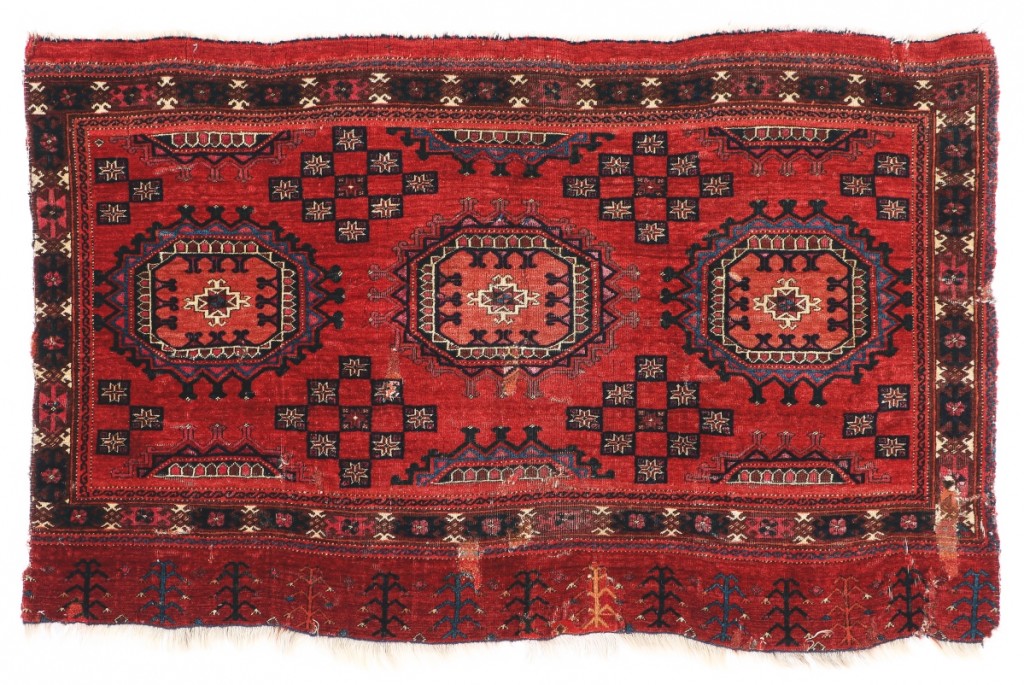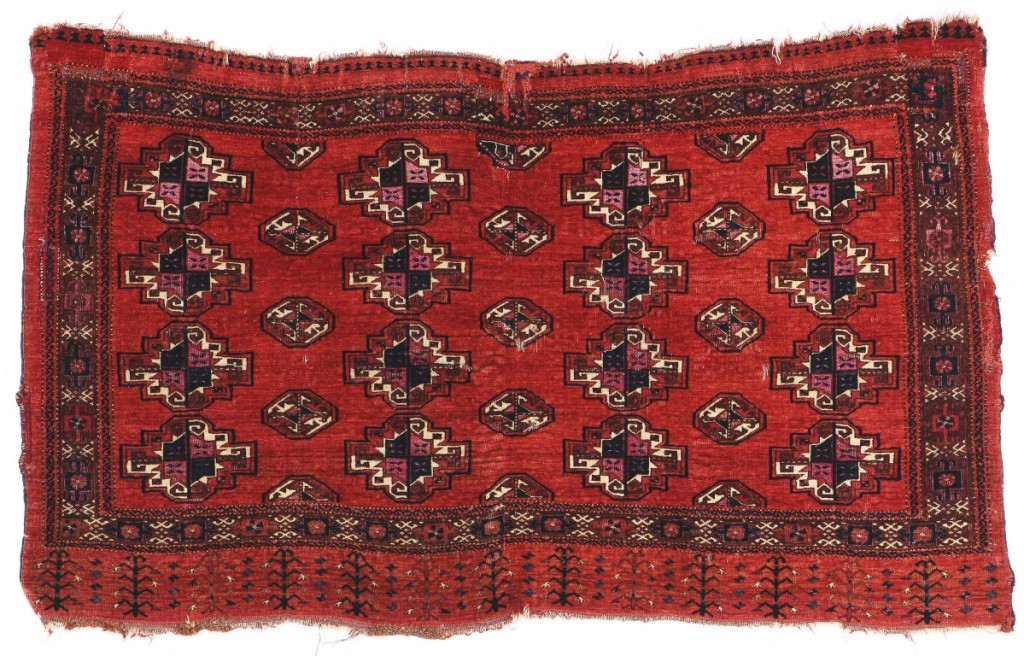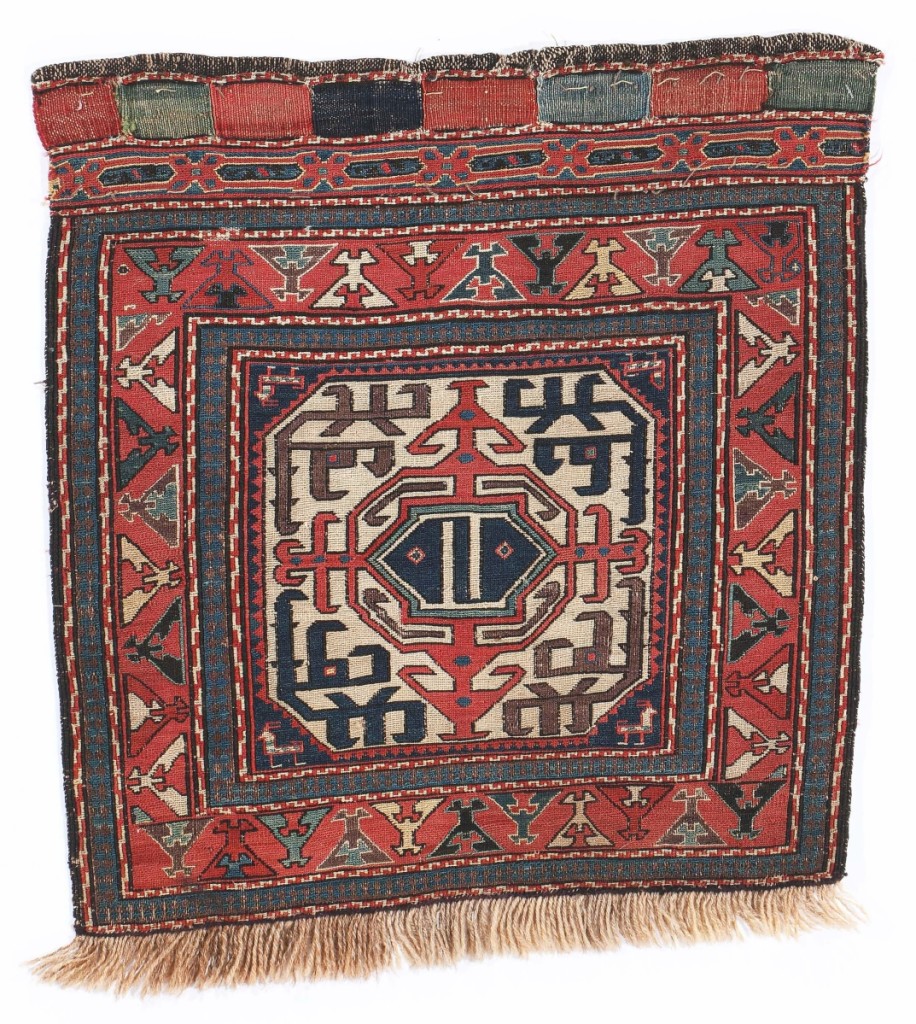
The top lot of the sale was a Salor chuval carpet from Eighteenth Century Turkmenistan, which flew to $59,375 to an in-house bidder. The subject of both publication and exhibitions, the museum-quality carpet from the Leigh Marsh collection measured 4 feet 2 inches by 2 feet 8 inches.
Review by W.A. Demers
PHILADELPHIA – A bright, crimson Salor Chuval carpet from Eighteenth Century Turkmenistan flew to $59,375 at Material Culture’s June 27 sale of the Leigh Marsh collection. The maida-gul-type textile, circa 1800, from the Marsh collection featured a middle row with large maida-gul turreted octagons beautifully executed with a partial row at the top and bottom disappearing under the respective border, suggesting the desirable feature of an “infinite repeat.” It was exhibited and published in Dodds and Eilan Jr’s Oriental Rugs From Atlantic Collections, Philadelphia, 1996, and “Masterpieces of Turkmen Weaving” at the Arthur Ross Gallery, University of Pennsylvania, Philadelphia, 2003, as well as the Corcoran Gallery, Washington, DC, and the Textile Museum. Its size is 4 feet 2 inches by 2 feet 8 inches. The carpet went to an American collector bidding in the gallery, according to George Jevremovic, the firm’s founder and principal.
There was a well-attended public exhibition June 23-26 leading up to the sale with an informal gallery talk presented by Dennis Dodds, secretary general of the International Conference on Oriental Carpets (ICOC), an organization advancing the understanding of Oriental carpets and the textile arts. “He knew the collection quite well and picked 28 carpets from it and used them as a sort of show and tell of styles and history,” said Jevremovic.
Leigh Andrew Marsh, who died in 2019 at the age of 90, was a connoisseur of antique tribal and village rugs and trappings, which have been avidly collected and studied for the better part of a century. He was born March 4, 1929, in West Newton, Penn., to James and Helen Marsh. From a young age, he loved animals and wanted to be a veterinarian. He achieved this goal by attending Penn State University and ultimately earned a VMD from the University of Pennsylvania in 1959 to become a doctor of veterinary medicine. Beyond his love for animals, however, he was a passionate collector of rugs and fine art. He could talk for hours about the motifs, colors and weaves of a Turkmen rug or the brushstrokes used by a painter from the Bucks County impressionist school.

This Salor juval, thought to be early, was won by a phone bidder for $43,750. The 4-foot-6-inch-by-2-foot-10-inch carpet ranks high among similar rare pieces in private collections, and, like the sale’s top lot, was extensively published and exhibited.
The sale offered seasoned collectors a chance to enhance their inventories, while more casual buyers could find exemplary weavings in a wide price range, all carrying the Marsh provenance.
That provenance was museum quality in that he was not only an enthusiastic collector but also delighted in conducting erudite discussions regarding virtually every aspect of rustic weaving, weavers and their cultures. He met or knew most of the major rug scholars and dealers, and reveled in the festive world of auctions, conferences and parties where co-enthusiasts were likely to be.
And rather than salting his most significant pieces out of sight, he availed his collection for exhibitions and publications. Many of his pieces, like the top selling Salor chuval, can be found throughout the existing literature and many previously exhibited and published examples were in this sale. Attracting mostly private collectors in the United States and Europe, total sales were $527,360, and of the 191 lots offered, 174 sold and were 17 passed. A little over 1,000 bidders were registered through online platforms, left bids and phones – which were very active – with about 20-30 people in the auction gallery.
The Marsh collection, with its important Turkmen component, further contributed a notable example when a phone bidder successfully bagged a Salor juval thought to be early for $43,750. The 4-foot-6-inch-by-2-foot-10-inch carpet ranks high among similar rare pieces in private collections, according to catalog notes. A kochanak border surrounds a spaciously composed field of large archetypal chuval guls of generous height interspersed with smaller octagonal guls, which disappear beneath the upper and lower borders. Along the elem at the bottom is a row of spare, elegant trees, each topped by a kochak rams-horn device. Like the Salor chuval, it was both published and exhibited in the Dodds/Eiland Jr publication, Ross Gallery, Corcoran Gallery and Textile Museum.
Fetching $26,250 from an in-house bidder was another Turkmenistan carpet from circa 1800, a Salor torba. The carpet’s primary elements are repeated octagons spaciously arrayed on a brilliant red ground interspersed with ornaments that are occasionally seen in the centers of some Salor medallions. Catalog notes cite Robert Pinner, who wrote, “Only a few torbas are known with this design, which has the serene elegance we have learned to expect from the Salor.” As an independent motif, however, Pinner noted that it is rare.
Online bidders were successful on a mid-Nineteenth Century Shahsevan Khorjin face, Trans-Caucasus, bag face and a late Nineteenth Century northwest Persian serapi. The former at $19,200 represented one of only a handful of fine sumak khorjin faces with a large octagon on an ivory ground containing what appear to be dragon-like forms, two in pale aubergine and two in deep indigo. Some suggest that the small dots are “eyes” of the beasts, and the various appendages and attachments are scales on the dragon’s body and limbs. In each corner, hardly noticed, are four diminutive and delicately drawn birds with harlequin markings and three of which show double crested feathers on their heads.

Can you see the “eyes” of a dragon-like beast in this mid-Nineteenth Century Shahsevan Khorjin Trans-Caucasus bag face? An online bidder who paid $19,200 for it will be studying its attributes.
The serapi brought $15,360. Measuring 8 feet 8 inches by 11 feet 3 inches, it’s an unusual antique carpet with a bright and cheerful palette, the large red medallion sits on a white field with four large palmettes in each corner.
Two consecutive lots, a Turkmenistan Tekke chuval, circa 1800, displaying 16 refined hexagonal guls with tall proportions that are spaciously arranged on a spare field, and a similar example from the first half of the Nineteenth Century warned $13,750 and $12,500, respectively.
And lest you thought this was just a sale of Oriental carpets, Marsh’s eye for fine art was included among the top selling lots when a painting by Richard Gibson Wedderspoon (American, 1889-1976) of three African American gentlemen seated on a town bench, in Naples, Fla., with a half-hidden female standing figure, took $11,250, won by a phone bidder.
After the sale, Jevremovic said he was most surprised by the high level of interest. “A lot of collectors of Turkmen rugs are ‘seasoned,'” he said, with fairly complete collections. “So it was good to see a level of high interest and a strong sell-through rate.” Prices given include the buyer’s premium as stated by the auction house.
The next high-end antique Oriental carpet sale will take place toward the end of August.
For information, 215-438-4700 or www.materialculture.com.




















